
The






Apartnership between Harvard University and the City of Boston, the Arnold Arboretum stewards one of the world’s most comprehensive collections of temperate woody plants in a 281-acre landscape in Boston. The Arboretum is an urban oasis and outdoor classroom that provides free access and learning opportunities for the public every day of the year. Designed by pioneering American landscape architect Frederick Law Olmsted, it is a jewel in Boston’s Emerald Necklace of parks and a National Historic Landmark.
The Arboretum’s collections of temperate woody plants have a particular focus on the floras of eastern North America and eastern Asia. The living collections, herbarium, and library and archives support research both in our own laboratories at Weld Hill and by scholars around the world, advancing scholarship across a range of disciplines and across community and professional audiences.
The Arnold Arboretum is a museum of trees teaching the world about plants.
Arborist Robert Ervin (right) demonstrates tree-climbing techniques with Greenhouse Gardener Emily Hitchcock (center) and Seasonal Gardener Zach Shein.
Cover: Concept for planned renovations to the Poplar Gate entrance to Peters Hill at the Arnold Arboretum, part of the Entrance Improvement Project. Image modified from an original rendering by Michael Van Valkenburgh Associates, Inc., 2023.
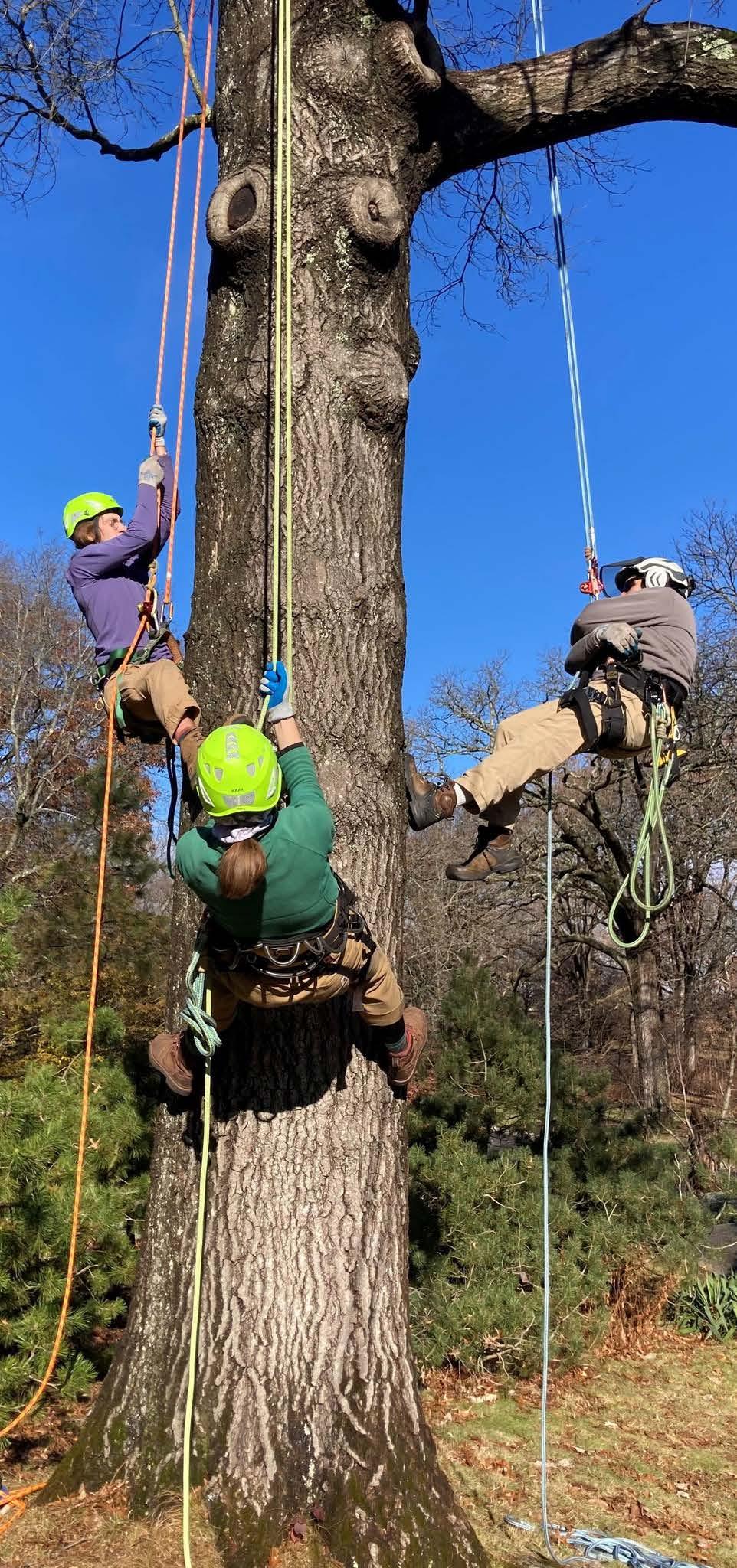

What we do at the Arnold Arboretum in a tree’s first year is crucial in shaping its future development and long-term prospects. Much of the work focuses at ground level as we endeavor to provide the right conditions and environment to encourage vigorous root growth and firm anchoring. Providing a strong and healthy foundation early on means the tree can shift more of its energy to developing its above-ground portion in future seasons.
This seems an apt metaphor to reflect on our institution and its progress in 2023—which I view as a seedling year in stewarding our next century as a museum of trees teaching the world about plants. In 2022, we celebrated 150 years of collecting, studying, and preserving temperate biodiversity in our urban oasis. The milestone offered a unique opportunity to engage our community in an ambitious vision centered on two themes: renewing and reinvigorating our historical commitments to equity in our landscape and combating global change and extinction in the plant world. This annual report documents some of the highlights and accomplishments of our first full season of growth toward this vision.
In early 2023, we launched our Entrance Improvement Project, a keystone effort to bolster equity in our landscape and make the Arboretum more welcoming and receptive to the million-plus visitors who come each year. We break ground on this project in the coming year with a renovation of Poplar Gate, which connects us to neighbors in nearby Environmental Justice Communities. On the climate front, we completed the second phase of our master plan to protect our plants from drought by installing emergency irrigation across sixty acres of collections on Peters Hill. Additionally, we introduced a new fellowship to attract early career scientists to study global change as part of our research community at Weld Hill. As America’s first public arboretum and Boston’s first free cultural institution, we remain dedicated to preserving our world-class collections and promoting health, learning, and happiness for everyone in our landscape.
Much of our growth in 2023 was only possible through the care and philanthropy of our supporters—from introducing a collaborative program with institutions in China to study and conserve vanishing biodiversity to onboarding a new summer learning experience for middle school students. While steadfast donors and members have increased their support, many new contributors have been inspired to join us. Annual memberships and donations, combined with capital giving to our Sesquicentennial Campaign, increased the philanthropic share of our operating budget from 9% in 2022 to 17% in 2023. Our transformative plans for advancing equity and addressing global change depend on our sustaining this upward trajectory in engaging new philanthropic support.
Individual commitments to our work help us to improve life in Boston and contribute to protecting and preserving biodiversity here and around the world. I am profoundly thankful to everyone in our community who has provided thoughtful support for the Arboretum and its mission. Memberships and gifts create the right conditions and environment for us to pursue excellence in all we do. I look forward to sharing more of the progress we achieve together in the seasons ahead.
 William (Ned) Friedman Director of the Arnold Arboretum
Arnold Professor of Organismic and Evolutionary Biology, Harvard University
William (Ned) Friedman Director of the Arnold Arboretum
Arnold Professor of Organismic and Evolutionary Biology, Harvard University
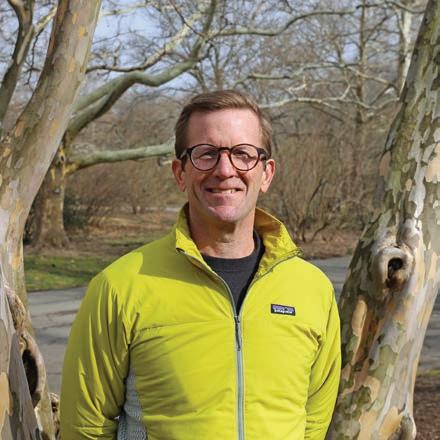
The Arnold Arboretum pursues excellence in horticulture as a botanical museum and research collection of woody plants, a legacy that will continue to flourish with the appointment of Rodney Eason as Director of Horticulture and Landscape. A leader in the public gardens field with over 25 years of experience growing plants and managing garden landscapes, Eason began work in this pivotal role in December 2023.
As Director of Horticulture and Landscape, Eason will lead colleagues in the Horticulture and Plant Production departments in developing a long-term vision for our 281-acre landscape, both to maintain and enhance the design originally developed by Frederick Law Olmsted. In this effort, he will work closely with Michael Dosmann, Keeper of the Living Collections, to ensure that some 16,000 woody plant accessions continue to thrive, educate, and inspire. “I have known Rodney for over 20 years and his experience and reputation in the industry is second to none,” Dosmann says. “There is no one I would rather work with to plan and implement the vision for the Arnold Arboretum’s landscape and collections.”
Eason served previously as the Chief Executive Officer at the Land & Garden Preserve in Mount Desert Island, Maine, where he led efforts to transition 1,400 acres of land adjacent to Acadia National Park from private ownership to welcoming public spaces and the incorporation of the Abby Aldrich Rockefeller Garden into the Preserve. Eason’s experience also includes serving as Director of Horticulture and Plants Curator at Coastal Maine Botanical Gardens and as Display Division Leader at Longwood Gardens in Pennsylvania. He received a master’s degree in public horticulture from the University of Delaware and a bachelor’s degree in landscape architecture from North Carolina State University. His outstanding contributions to horticulture were recently recognized by the Massachusetts Horticultural Society with their Silver Honorary Medal.
“Being the Director of Horticulture and Landscape at the Arnold Arboretum is a position my career has prepared me for, at a renowned institution that I have always admired.”
—Rodney Eason
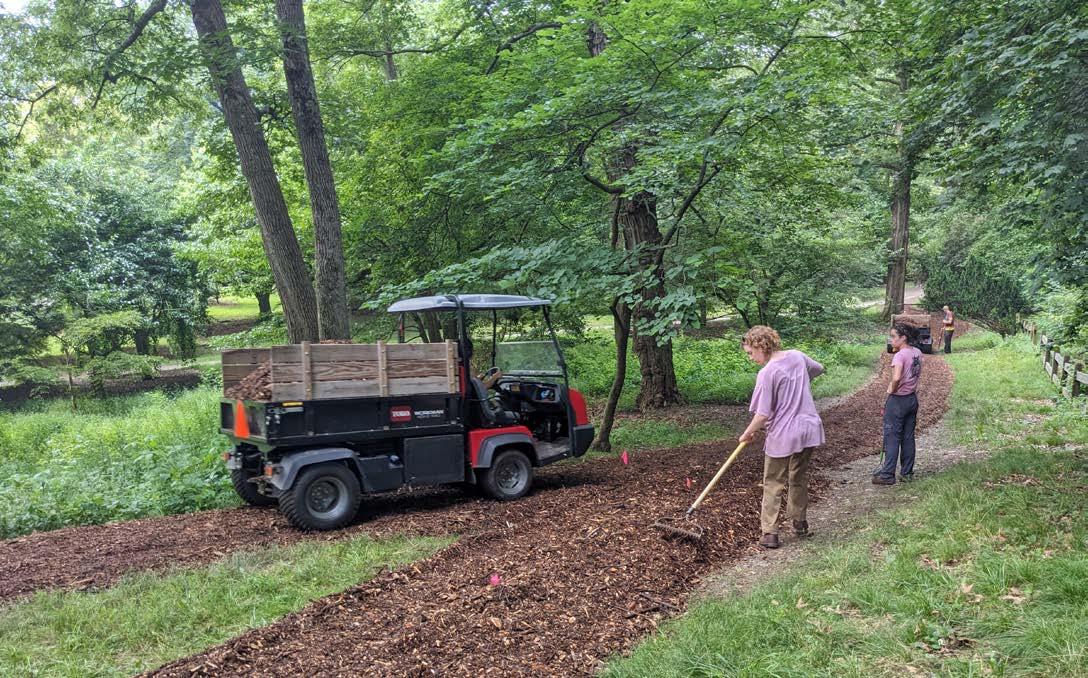
In addition to the road system designed by Frederick Law Olmsted, formal and informal pathways draw visitors deeper into the Arnold Arboretum landscape and invite more immersive experiences in the living collections. In 2023, the Arboretum took steps to renovate Linden Path and the Bridle Path, two key conduits connecting Meadow Road to the North Woods and the Leventritt Shrub and Vine Garden. In addition, horticulture staff continued the Arboretum’s momentum in adding and maintaining new mulched paths throughout the landscape’s 281 acres.
The 2023 cohort of our Isabella Welles Hunnewell horticulture interns focused their capstone project on restoring and renewing the historical Bridle Path, originally constructed in the 1920s to allow passage for horseback riders. Working with the curation, horticulture, and greenhouse teams, interns removed low-value and redundant plantings to create new viewsheds and open space for a new shade-loving shrub collection to complement similar collections in the nearby Leventritt Garden. Efforts also included restoring the pathway itself with the addition of more than 100 yards of mulch over some 1,000 linear feet of path, remediating compacted soils along its length, and creating planting recommendations for the future.
Nearby Linden Path was also the subject of a renovation and resurfacing project that began in the fall. As part of the restoration work, the path was widened to seven feet to improve accessibility and two-way mobility for visitors. Renovations were completed over the winter, and staff plan to complete renovations to the rest of the Leventritt Garden pathway system in spring 2024.
2023 Hunnewell Interns
spread 100 yards of mulch over Bridle Path, the finishing touch on their capstone project to renew the path and its plantings.
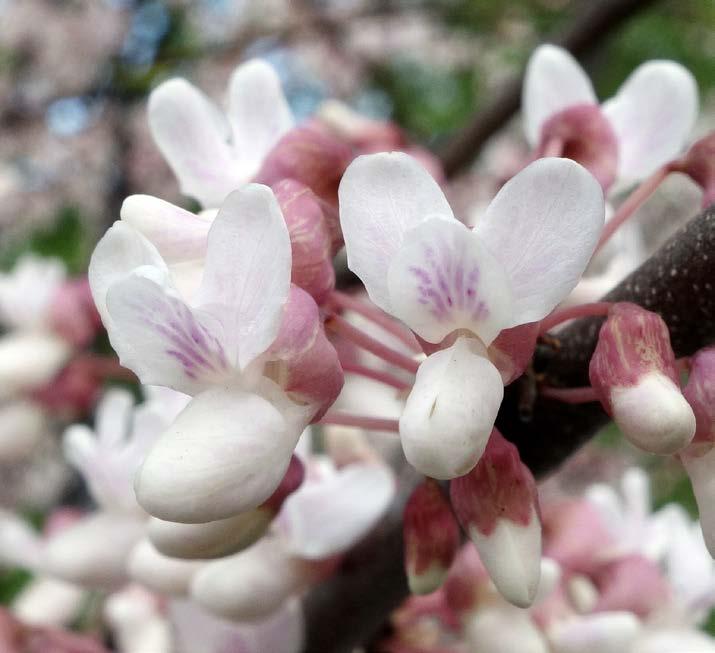
Plant Production staff unveiled a fresh contribution to the Arboretum’s horticultural legacy by introducing Cercis canadensis ‘Arnold Banner’ in 2023, a beautiful new redbud cultivar. First observed by staff in 2009 as a spontaneous mutation of a single branch of an Eastern redbud near Linden Path, the cultivar was described by Arboretum Director William (Ned) Friedman and colleagues in the December 2023 issue of HortScience following more than a decade of research and testing by the Arboretum and partners in the nursery trade.
What sets ‘Arnold Banner’ apart is the almost total absence of color of its flowers. The species is known for its clusters of pea-like flowers that emerge directly from the trunk and oldwood branches before leaf-out. Whereas the species bears pink to magenta flowers, the petals of ‘Arnold Banner’ are mostly white yet retain soft pink striping on the banner petal. Known as “nectar guides,” these markings play a role in helping insects pollinate the flowers. To the human eye they provide a subtle and charming detail of horticultural interest.
Testing by the Arboretum and its nursery partners has shown robust growth of ‘Arnold Banner’ across the USDA hardiness zones ranging from 6a to 8b. While its flowers are unique, ‘Arnold Banner’ appears to hold true to other characteristics of the species including a low branching and multi-stemmed habit and a spreading vase to rounded form. Although several white-flowered cultivars of Eastern redbud have appeared commercially, ‘Arnold Banner’ appears to be only the second instance of a mostly white-flowered redbud to be recorded. “Random mutations that lead to novel and desirable characteristics in plants are rare,” said Friedman. “With ‘Arnold Banner’ we celebrate this ongoing evolution, and the role plant collections like ours can play in their discovery, evaluation, and appreciation.”
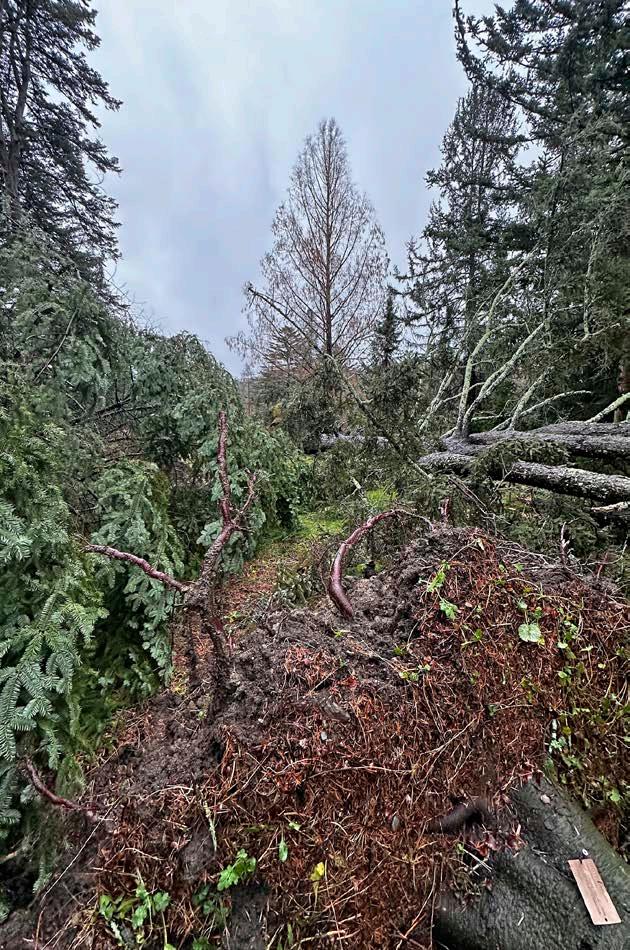
Some of the most severe damage in the December 18 storm occurred in the conifer collection, where 15 trees—primarily firs and spruces—were lost.
Nearly 40 accessioned trees across the Arboretum landscape were lost in a major winter storm that swept across New England on December 18, 2023. While the storm was formidable in terms of tree loss and the enormity of the clean-up effort, the immediate and coordinated response of the Arboretum’s horticultural team ensured safety for visitors and renewal for the plants either lost or severely compromised.
The storm broke records for generating some of the strongest winds— outside of thunderstorms—seen in Boston in a decade. Horticulture staff characterized the damage by organizing affected trees into three response categories—total losses requiring removal, plants that survived but incurred significant damage and may require additional intervention or monitoring, and plants either lost or damaged that need to be regenerated. The conifer collection suffered the most losses—15 trees, primarily aging firs and spruces—and ten trees were lost on both Peters Hill and Hemlock Hill. Many more plants were damaged by falling trees, including a Tatarian maple on Peters Hill that was crushed by a snapped oak. Most plants that sustained collateral injuries stand a good chance of surviving, but staff will continue to monitor their health and condition in coming seasons.
Fortunately, all losses of high value to the collection (plants key to the Arboretum’s research mission due to their rarity, conservation value, or provenance) had already been duplicated (cloned) at the Arboretum through ongoing repropagation efforts. Another bright spot in recovering from a storm of this magnitude is the renewal it engenders for the entire Arboretum collection. Germplasm of key plants may be preserved and refreshed through repropagation, and the spaces they inhabited offer new planting opportunities. Additionally, data recorded by Arboretum staff about this storm and the trees lost and injured will contribute to our understanding of how extreme weather events and climate change are affecting trees at the Arboretum.
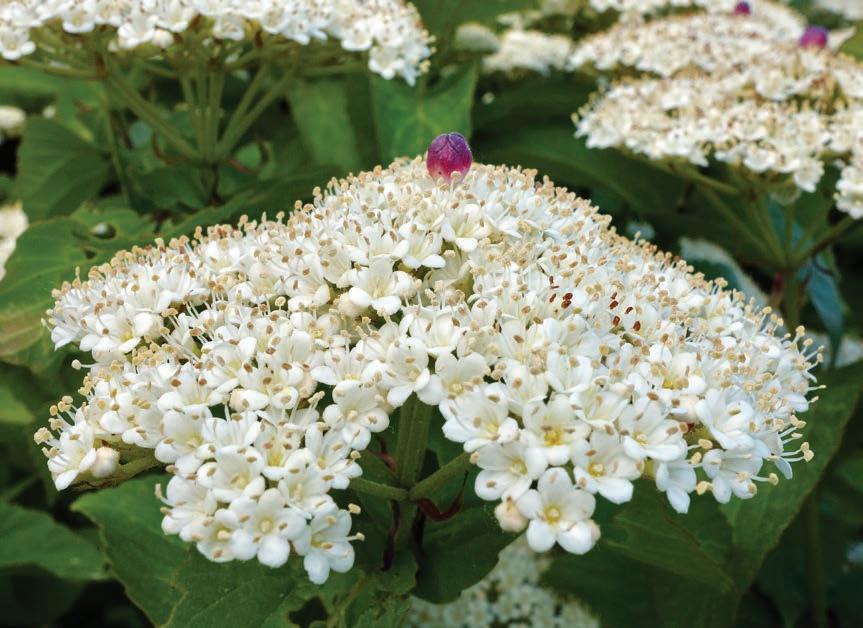
Arnold Selects, the Arboretum’s Plant Introduction program, blends the art and science of horticulture to promote the cultivation of exceptional plants in American gardens. Working with partners in the commercial nursery industry, Arnold Selects marshals more than 150 years of experimentation and expertise to bring plants central to our legacy to consumers. In 2023, the Arboretum offered its first cultivar release through Arnold Selects, the ‘Crimson Gem’ bracted viburnum (Viburnum bracteatum).
The story of ‘Crimson Gem’ begins in the 1980s, when multiple expeditions were mounted to facilitate ex situ conservation of plants at the Arboretum in concert with the Center for Plant Conservation. Bracted viburnum was among the endangered plants targeted for collection, and the Arboretum’s assistant plant propagator Rob Nicholson dug a division of the plant in Franklin County, Tennessee, which was planted into the viburnum collection in September 1992. Nearly two decades later, a lab technician at Brown University noticed something peculiar about the flower of this viburnum—the flat-topped inflorescences feature a vibrant red floret in the center, similar to the herbaceous biennial Queen Anne’s lace (Daucus carota). Flowers open in their entirety in late May to early June, enveloping the shrub, each revealing the magical middle “gem.” Additionally, its attractive spring foliage emerges with an ephemeral reddish hue and finishes the season in autumn by turning bronze to maroon before defoliating. Clusters of shiny, blue-black drupes add additional interest in fall and winter and are consumed by wildlife.
After more than 30 years of testing in the Arboretum landscape, ‘Crimson Gem’ bracted viburnum has stood the test of time. Sharing this unique cultivar with nurseries through the Arnold Selects program may help give a leg up to an endangered native species, and celebrates our legacy of exploration, horticultural testing, and plant introduction.
Inflorescence of Viburnum bracteatum ‘Crimson Gem’.














As of December 2022, the living collections comprised 17,132 individual plants belonging to 10,913 accessions representing 3,828 taxa of woody plants.














As of December 2023, the living collections comprised 17,003 individual plants belonging to 10,859 accessions representing 3,795 taxa of woody plants.
Each year, the Arboretum welcomes about a million visitors through its many entrances, which include nearly 20 historic gates and informal portals. Though each is highly variable in design, aesthetics, and ease of passage, the Arboretum’s entrances are united in purpose—providing free access to a treasured urban landscape. Decades of shifting transportation needs and availability of resources have degraded the overall experience of arrival for visitors, characterized by an expansion of asphalt paving, compromised safety and accessibility, and a reduction in planting space. To improve the entrances and address historical disparities in how the Arboretum welcomes visitors to its landscape, the Arboretum launched a multi-phased capital plan in 2023 to improve all the Arboretum’s entrances toward a safer, more accessible, and more welcoming experience.
Stewarded by the storied landscape design firm, Michael Van Valkenburgh Associates (MVVA), the project launched with an analysis of five key entrances: Washington Street Gate (opposite the Forest Hills MBTA station), Poplar Gate, Walter Street Gate, Arborway Gate, and Beech Path Gate. Selected chiefly for their connectivity to diverse audiences, these five entrances serve neighborhoods deemed as Environmental Justice Communities, provide improved access for adjacent health care institutions, and support infrastructure partnerships along our perimeter with the City of Boston and Massachusetts. Construction will kick off in 2024 for renovations to the Poplar Gate entrance to Peters Hill, the first of these entrances to receive full funding from a private donor who is excited about improving access to greenspace for Boston residents.
Through much of 2023, the project team gathered feedback from the public and multiple city and state agencies to begin planning and concept design for the five entrances selected for the first phase of renovations. This work represents the defining element of the largest design initiative in our landscape since Olmsted’s time and complements other ambitions to improve visitor and commuter access including the Roslindale Gateway Path project. By seeking to improve all the Arboretum’s entrances to provide a safer, more accessible, and more welcoming experience for all, the Entrance Improvement Project honors the Arboretum’s legacy as a free cultural institution and its historical commitment to green space equity.

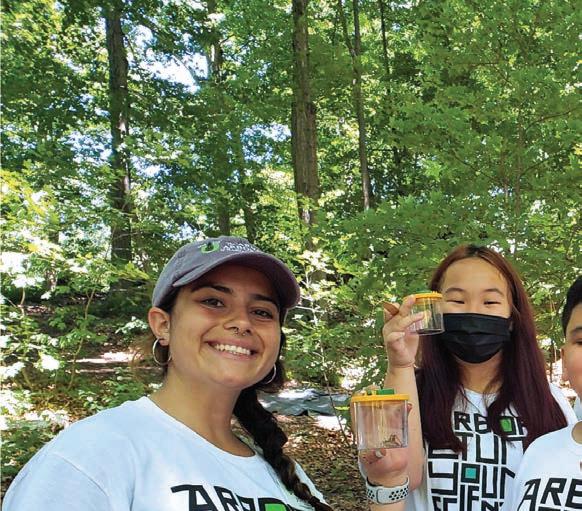


For four decades, the Arnold Arboretum has championed educational outreach programming in the life sciences to elementary school students, particularly through its longtime partnership with Boston Public Schools (BPS). In 2023, Arboretum educators presented a second year of a new summer program for middle school students—Arboretum Young Scientists. Bridging the Arboretum’s programming for Pre-K through elementary grades and learning opportunities for high school students, AYS represents a promising new extension of the Arboretum’s educational outreach to children in BPS with an eye on promoting both science learning and science careers.
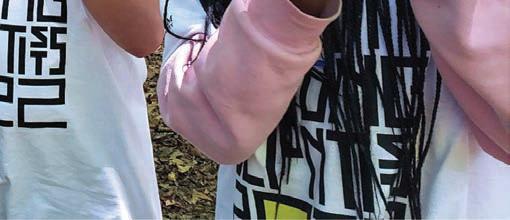
From photosynthesis to decomposition, from plant adaptations to the challenges of extreme drought, AYS students studied a wide range of STEM-focused topics over the course of their four-week experience at the Arboretum in July 2023. They examined nature up close, and learned the practical ways that scientists investigate the natural world by gathering data and recording observations. They also enjoyed fun opportunities to build community with their peers and explore the diverse ways we study and care for plants at a public garden.
Through Arboretum Young Scientists, our educators immerse Boston’s middle school students in life science at a critical time in their educational development. Additionally, the program prioritizes equity and inclusion in its reach and approach, working to reverse the historical lack of diversity in the sciences. Supported by private philanthropy, AYS will continue to grow and evolve as it enters its third season in 2024. The success of its first two seasons indicates the program is fulfilling a need, and its mission has enjoyed broad support with participating schools and classrooms. Looking ahead, AYS fosters the Arboretum as a place where all students in Boston—particularly from communities of color—will find comfort in nature and see the potential impact that science and STEM-related fields can have on their future.
Arboretum Young Scientists unleashes curiosity and ignites a passion for science through an immersive experience for rising 7th and 8th graders in Boston Public Schools.
Participating students in Arboretum Young Scientists spent four weeks in our landscape in July 2023 learning about life science research and STEM-related careers. Through additional donor support, the program will be extended to a five-week experience in 2024.
BETHANY VERSOY
Our Visual Archives document the history and activities of the institution and include over 80,000 items.
In a photograph taken by Ernest Henry Wilson on expedition in Korea in August 1917, a Korean man stands next to a Dahurian birch tree (Betula dahurica) in Hamgyeongbuk-do, Korea (North).
Among the archival treasures held by the Arnold Arboretum are more than 80,000 images documenting the living collections, our evolving landscape, and over a century of botanical expeditions. In spring 2023, Lisa Pearson, Head of the Library and Archives, began a project to redescribe historical photographs taken by Ernest Henry Wilson on his 1917-18 expedition to Korea—images now displayed in large format at the Weld Hill Research Building. The project was recommended by the Arboretum’s staff committee for diversity, inclusion, and belonging to address concerns of colonialism, the institution’s collaboration with occupying forces from Japan, and a lack of acknowledgement of assistance provided to Wilson by indigenous Korean guides.
Assisting Pearson was Professor Jaeyong Choi of Chungnam National University (CNU), Environmental and Forest Resources Department, who spent a sabbatical year at the Arboretum in 201819. Choi provided guidance in correct forms of Korean place names and in revising our descriptions and captions for the photographs. He also enlisted colleagues from CNU to help identify and interpret the clothing worn by individuals in the images. The project was completed in time for a visit by staff from the Korea National Arboretum in June.
The effort inspired a parallel initiative to revise and contextualize the archival documentation for all 351 of the Arboretum’s historical photographs taken in Korea during the Japanese occupation by plant explorers Wilson, John Jack, and Frank Meyer. This project included updating image descriptions to include the nomenclature of plants, detailed location information where it was lacking, and the names (when known) of people photographed. Variant titles were also added to describe the photographs for the visually impaired. This project served as test case for a larger reparative cataloging project the library plans to mount in 2025 through grant funding.






















































For more than a century, the Arnold Arboretum has conducted plant collecting expeditions across the temperate world to study biodiversity and amass a world-class collection of trees, shrubs, and vines in Boston. In fall 2023, Arboretum staff mounted an expedition in Japan, resuming international field work for the first time since the global pandemic. The two-week trek through forests across seven Japanese prefectures yielded 20 species of woody plants important to our work in research and conservation.
The expedition was planned and organized by the Arboretum’s new assistant curator, Miles Schwartz Sax, who set off for Japan with Keeper of the Living Collections Michael Dosmann in mid-September. Joining the Arboretum team were in-country collaborators Mineaki Aizawa, Associate Professor in the Department of Forestry at Utsunomiya University, and undergraduate student Yoshinari Hata. The expedition marked the Arboretum’s fourth collaboration with Professor Aizawa and his lab to study and collect from Japan’s native biodiversity as part of the Arboretum’s 10-year collecting initiative, the Campaign for the Living Collections.
Japan’s diverse temperate flora has enticed Arboretum plant collectors for more than 130 years. Wild-collected acquisitions have generated a rich repository of germplasm—plants of Japanese provenance rank third in our collections behind the United States and China. Campaign targets gathered on this expedition include the hornbeam maple (Acer carpinifolium), Japanese tree lilac (Syringa reticulata), Siebold viburnum (Viburnum sieboldii), Kyushu lime (Tilia kiusiana), sawleaf zelkova (Zelkova serrata), lance-leaved piratebush (Buckleya lanceolata), and Japanese hop-hornbeam (Ostrya japonica). Seeds of Mitchella undulata, a groundcover plant related to our native partridge berry (M. repens), represent the Arboretum’s first collection of this species. In addition to the seeds, herbarium specimens, and extensive written documentation gathered, photographs captured on this expedition provide another key resource that will assist future biodiversity study and become part of our expeditionary archives.

Close evolutionary relationships between plants native to eastern North America and species endemic to temperate regions of eastern Asia have made China— home to nearly 5,000 native tree species—a collecting focus for the Arboretum since the early 1900s. To help protect this biodiversity and provide safe harbor for threatened species, the Arboretum launched the China Conservation Collaboration Initiative (CCCI) in 2023. Funded by friends of the Arboretum in China, the initiative combines plant exploration, horticultural practice, and scholarship to conserve plants cooperatively while building critical capacity in China to collect, preserve, and study their botanical heritage.
Page 12. Fall 2023 Japan Expedition participants trek through Utsonomia University Research Forest in Funyu, Japan.
Page 13. Assistant Curator Miles Schwartz Sax, shown collecting in the field, serves as project coordinator for the China Conservation Collaboration Initiative.
Collaboration partners in China include the National Botanical Garden in Beijing, the Kunming Institute of Botany, and Zhejiang University. Donor funding supports cooperative activities with CCCI partners including monitoring and documenting natural plant populations to better ensure their survival in situ; establishing ex-situ collections of wild-collected plants at botanical gardens and arboreta in China and in the United States; and exchanging horticultural knowledge and best practices by connecting professionals in Chinese and American gardens for training in propagation, nursery management, and horticultural care. A portion of funding also helps underwrite activities at the Arboretum in support of ex-situ conservation for international plant species held in the living collection.
The signing of a memorandum of understanding between the partner institutions in August 2023 officially launched the academic collaboration, which has committed funding until 2027. Project coordinator Miles Schwartz Sax is leading efforts to research species ranges, local vulnerabilities, and other factors driving species occurrence and abundance in China. His findings will inform in-country field work by our China-based partners to obtain germplasm, genetic samples, and herbarium vouchers, as well as advance scholarship on China’s threatened biodiversity. Working with new and existing partnerships, this bold initiative will have measurable impact in the preservation of threatened species in China, the world’s hotspot for temperate biodiversity.
Our mission focuses on the preservation of the living collections’ global biodiversity, as well as the urban sanctuary that our plants inhabit.
The potential for hotter, drier summers driven by global change poses significant challenges to caretakers of our living collections. The prolonged effects of drought compound harm caused by pests, pathogens, and human-induced impacts including soil compaction and pollution. Since 2016, the Arboretum has worked with leading engineering firms and irrigation consultants to develop a master plan for bringing automated irrigation to the entirety of our collections. In 2023, staff focused these efforts on Peters Hill, historically one of the driest parts of the Arboretum and the most difficult to deploy manual during drought emergencies in our region.
The varied terrain and significant elevation changes of Peters Hill required the installation of electrical booster pumps and a pumping station. Downstream, large irrigation mainlines now span the entirety of Peters Hill, feeding dozens of access nodes for manual watering connection and future expansion of automated systems. With this layout, all collections on Peters Hill—which were previously watered using just one perimeter fire hydrant and mobile watering tanks—will be within just 150 feet of a water connection.
In total, the Peters Hill Irrigation Project will provide water for 2,738 specimens that currently endure dire conditions when rainfall is scarce, including our nationally accredited ginkgo collection and exceptional holdings of crabapples, pears, and hawthorns. This phase of work was fully funded by donors, and looking ahead the Arboretum seeks additional donor funding for the third and final phase of the project—safeguarding 60 acres of collections along Hemlock Hill Road and Meadow Road.
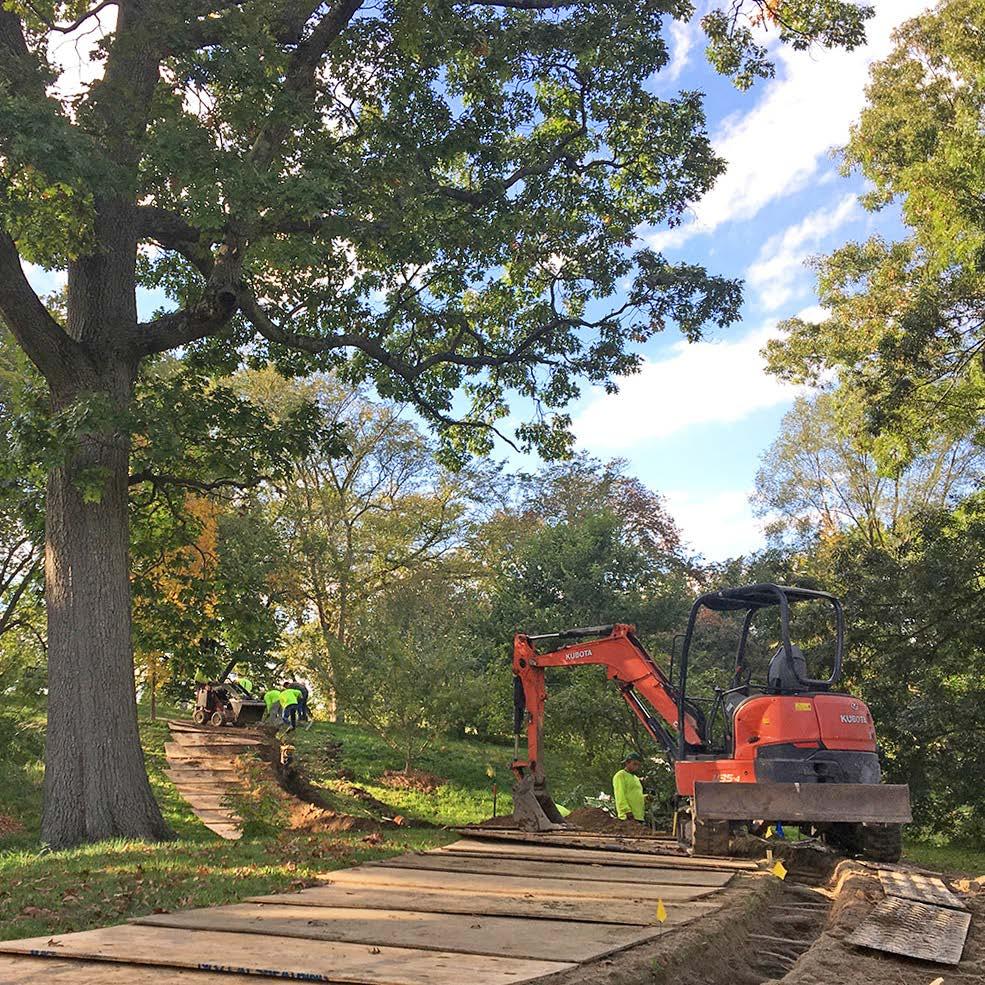

A hawk surveys the pollinator meadow growing beneath and around the 1,152 solar panels in the landscape of the Weld Hill Research Building.

The massive solar energy collection and storage system established next to our Weld Hill Research Building has become a model for sustainability in such efforts with the cultivation of a native plant pollinator meadow at the site. Wild-collected seeds of native perennials planted beneath, between, and around our array of 1,152 solar panels comprise an ecological and technological experiment to boost the ecological health of the landscape. The solar capture system and its underlying meadow both flourished in 2023, achieving success in two key sustainability initiatives—increasing the capture and use of renewable energy and enhancing habitat for urban pollinators and other wildlife.
Now beginning its third season, the solar meadow teems with more than 30 species of native, wild-collected herbaceous species, a number likely to increase with additional plantings in coming years. The variety of species sowed in the landscape ensures ready blooms for pollinators (and curious visitors) throughout spring, summer, and fall. Floral highlights include spectacular drifts of white yarrow (Achillea millefolium) and foxglove beard tongue (Penstemon digitalis), spires of blue vervain (Verbena hastata) and violet wild beebalm (Monarda fistulosa), and understory blooms of Virginia mountain mint (Pycnanthemum virginianum) and common boneset (Eupatorium perfoliatum).
Approximately 80 percent of flowering plant species depend on animal pollinators—primarily insects—to reproduce. Research by scientists around the globe indicates that more than forty percent of pollinator populations may disappear within the next decade, a prediction driven primarily by habitat loss, pesticide applications, and the pressures of global change. Our solar meadow at Weld Hill provides a rich environment to build insect habitat and increase their populations in the Arboretum landscape. It also offers the community a model for converting turfgrass to an environment that supports and boosts local biodiversity.
Celebrating 112 years of publication in 2023, our quarterly Arnoldia remains the standard bearer of communication for the Arnold Arboretum about the nature and nurture of trees. First established in 1911 as the Bulletin of Popular Information, the Arnold Arboretum’s quarterly magazine has long been the definitive forum for conversations about temperate woody plants and landscapes. As part of our sesquicentennial celebrations, Arnoldia relaunched with a fresh design, a dynamic and distinctly modern approach, and a richer sampling of the diverse voices driving contemporary thinking and scholarship about trees.
In 2023, Arnoldia presented its second complete volume featuring its new look and feel, a print and digital transformation marked by new points of access and new kinds of content. Over the course of the year, contributors shared stories of plant exploration, behind-the-scenes views of novel research, and deep dives into archival collections to explore the history of gardens, landscapes, and science. The magazine expanded its scope to consider trees through cultural and community lenses, encompassing poetry, visual art, and literary essays. Importantly, Arnoldia spotlighted new and traditionally underrepresented voices in conversations about science and nature.
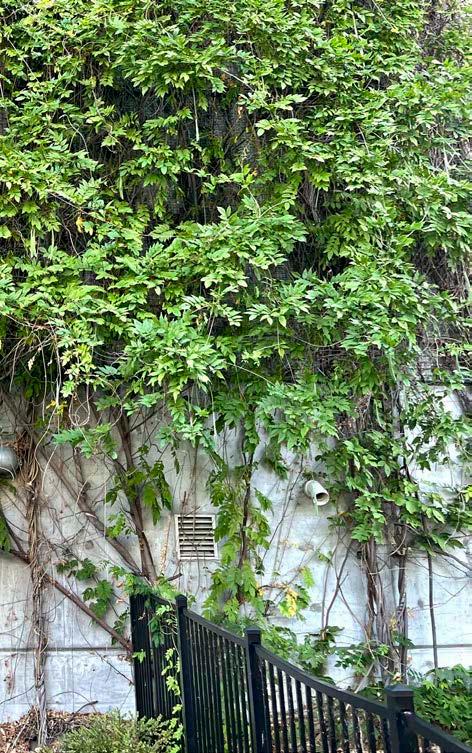
One of those new voices won special recognition when climate expert Bill McKibben selected Rachel May’s article, “The White Oak at McLean: a Case of Recovery” for inclusion in Best American Science and Nature Writing. The essay, which appeared in the winter 2023 issue of Arnoldia, explores the arboricultural history of one of the world’s foremost mental-health hospitals from the perspective of a former patient. May’s writing is a reminder of how the nature of trees impacts human lives, taking on meanings far beyond the edges of park and garden. Moving forward, Arnoldia is committed to exploring those meanings wherever they lead.
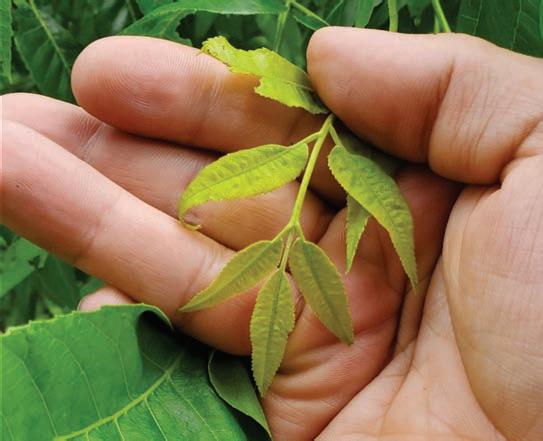
The living collections of the Arnold Arboretum comprise a valuable genetic resource representing a large subset of the combined woody floras of the North Temperate Zone. Arboretum plants and associated collections support comparative studies by scientists around the globe for studies across multiple disciplines. The curatorial department provided collecting permits, plant material, and research support for more than 80 research studies across 2022 and 2023.
Among the diverse projects utilizing Arboretum plants over this period was a study by Warren Chatwin, a research geneticist with the USDA Agricultural Research Service and recipient of the Arboretum’s Jewett Prize in 2022. Chatwin’s study sequenced samples from our nationally accredited hickory collection to develop a genetic analysis pipeline for the USDA to identify the species or hybrid status of unknown hickory samples collected for its national germplasm repository. Working with curatorial staff, Chatwin collected young leaf tissue from 216 wild-origin hickories and four hybrids in our collection for this key plant conservation initiative.
Our living collections also contributed to a study by Vidya Vuruputoor, a PhD candidate at the University of Connecticut and recipient of a 2024 Sargent Award, to assess genetic differences in hemlocks (Tsuga spp.), another nationally accredited collection at the Arboretum. Launched in 2021 and extended in each subsequent year, Vuruputoor’s research will compare hemlock transcriptomes—sets of RNA transcripts that drive gene expression—which have been shown to carry varying degrees of tolerance toward the species’ most destructive known pest, the hemlock woolly adelgid (HWA). At its completion, the study will generate a high-quality reference genome for eastern hemlock to compare against the Carolina hemlock and analyze potential structural variations that might signal HWA resistance.
Fresh young leaf tissue from accessioned plants in the Arboretum’s nationally accredited collection of hickories were harvested for DNA extraction as part of a research project by Warren Chatwin for the USDA Agricultural Research Service.
Arnold Arboretum collections supported more than 80 research projects in 2022 and 2023.
The Taylor lab studies how plants respond to and influence their environments, particularly in view of climate change.
Benton Taylor—Assistant Professor of Organismic and Evolutionary Biology at Harvard University and a Faculty Fellow of the Arnold Arboretum—studies how plants respond to and influence their environments, particularly in view of global change. Although Taylor’s primary focus is at the ecosystem scale, the research questions pursued by his lab at Weld Hill require investigating plants at molecular, individual, and community scales. The Taylor Lab advanced several important projects in 2023 to better understand the role of plants in global processes.
In Costa Rica, postdoctoral researcher Cecilia Prada led a large-scale experiment using custom-built chambers to expose tropical trees to elevated levels of carbon dioxide—mimicking future CO2 levels predicted by scientists. The study was designed to determine whether below-ground symbioses with mycorrhizal fungi and nitrogen-fixing bacteria will impact the trees’ physiological and biological responses to higher concentrations of atmospheric carbon. Also in the tropics, researcher Lindsay McCulloch completed sampling for an investigation of changes observed in vegetation and nitrogen cycling in tropical rainforests when a treefall opens the canopy.
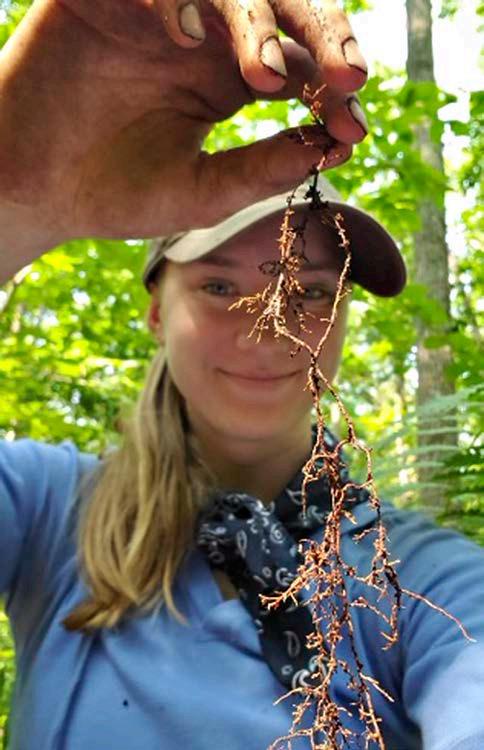
Moving to the Northern Hemisphere, PhD student Calvin Heslop mounted a field campaign in the Alaskan arctic to study how nitrogen-fixing alders impact the carbon and nitrogen cycles of the tundra. Closer to home, PhD students Nikhil Chari and Carina Berlingeri led an investigation at the Harvard Forest to assess how mycorrhizal fungi mediate competitive dynamics between trees, and how mycorrhizal symbioses impact the amount of carbon that trees fix into soils. Also during 2023, DaRin Butz Foundation Research Intern Maya Akazawa and technician Alaina Bisson sampled more than 130 trees at the Arboretum to learn if their belowground symbionts influence levels of herbivory in their leaves.
Harvard Forest REU student Katherine Almquist worked with PhD candidate Carina Berlingeri to study how roots and mycorrhizal fungi impact competition between forest trees.
To foster both independent and collaborative work, the Arnold Arboretum offers fellowships and awards to students, post-doctoral researchers, and professionals of the biological and horticultural sciences as part of its mission to discover and disseminate knowledge of the plant kingdom. The following individuals and their research proposals were awarded funding by the Arnold Arboretum in 2023:
ASHTON AWARD FOR STUDENT RESEARCH
Sumashini Pagaldevatti, PhD Student, University of Illinois at Urbana-Champaign: “The role of seed-fungal interactions in shaping coexistence of closely related tree species in the tropical forests of Western Ghats, India.”
CUNIN/SIGAL RESEARCH AWARD
Christina Hourigan, PhD Candidate, Royal Holloway University of London and Royal Botanic Gardens, Kew: “The making of a global arboretum.”
ARNOLD ARBORETUM GLOBAL CHANGE FELLOWSHIP
Megan Wilcots, PhD Candidate, University of Minnesota: “Arctic nitrogen fixation: A potential mechanism to mitigate the climate crisis?”
JAMES R. JEWETT PRIZE
Jessica Savage, Associate Professor, University of Minnesota Duluth: “The sweet path to discovery: Finding connections between phloem structure and function.”
PUTNAM FELLOWSHIP
Camilo Villouta, PhD Candidate, University of Wisconsin-Madison: “Reproductive tradeoffs involved in the evolution of freezing survival strategies in woody perennial buds.”
SARGENT AWARD FOR VISITING SCHOLARS
Wyatt Oswald, Professor, Emerson College: “Reconstructing the vegetation of the Holm Lea estate with a lake-sediment pollen record from Sargent’s Pond.”
SINNOTT AWARD
Ashanti Shih, Assistant Professor, Vassar College: “Colonial legacies of the Arnold Arboretum.”
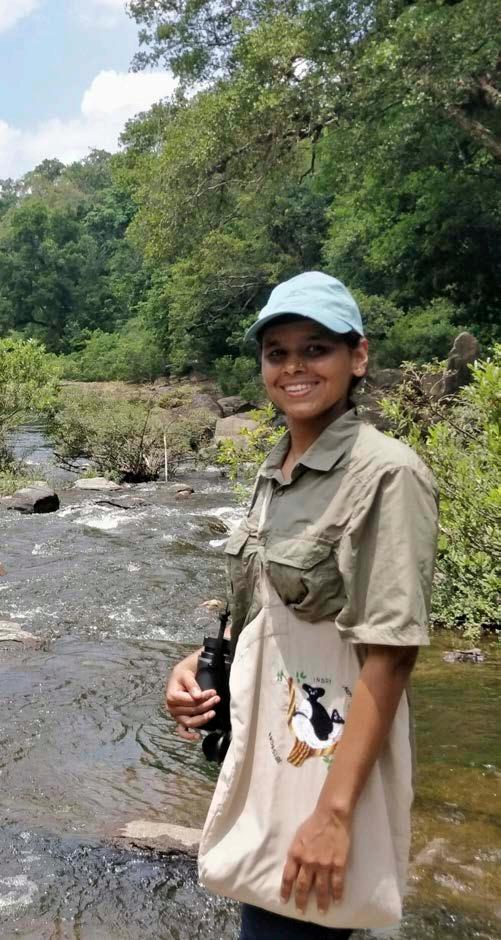
Sumashini Pagaldevatti received the Ashton Award to examine the interaction between fungal pathogens and seeds and the impact of this interaction on the recruitment and diversification of plant species in tropical forests.
Faculty Fellows of the Arnold Arboretum of Harvard University contribute significantly to one or more of five areas central to our mission: leading or collaborating on research based at the Arboretum; mentoring students and postdoctoral fellows based at the Arboretum; teaching Harvard courses based at the Arboretum; providing input on living or archival collections and landscape management; and creating outreach programs to share science with the public.
William (Ned) Friedman
Arnold Professor of Organismic and Evolutionary Biology
Director of the Arnold Arboretum of Harvard University
Faculty Fellow of the Arnold Arboretum of Harvard University
N. Michele Holbrook
Professor of Organismic and Evolutionary Biology
Charles Bullard Professor of Forestry
Faculty Fellow of the Arnold Arboretum of Harvard University
Robin Hopkins
Professor of Organismic and Evolutionary Biology
Faculty Fellow of the Arnold Arboretum of Harvard University
Elena Kramer
Bussey Professor of Organismic and Evolutionary Biology
Harvard College Professor
Faculty Fellow of the Arnold Arboretum of Harvard University
Benton Taylor
Assistant Professor of Organismic and Evolutionary Biology
Faculty Fellow of the Arnold Arboretum of Harvard University
Highlighted authors are Arboretum staff, Arboretum Visiting Scholars, Fellows, and Associates; Arboretum Putnam Fellows*, Arboretum Global Change Fellows**, Arboretum Award Recipients†, and Arboretum Interns‡
Acevedo I. 2023. From the river to the road. Arnoldia 80-4:14–15.
Acevedo I. 2023. Sakura storytellers. Arnoldia 811:30–43.
Battles M. 2023. A finer constitution. Arnoldia 802:9–10.
Battles M. 2023. Balm for a world of wounds. Arnoldia 80-2:1–2.
Battles M. 2023. Magnitudes of magenta. Arnoldia 80-2:55–57.
Battles M. 2023. Sequoiadendron giganteum. Arnoldia 80-1:18–19.
Battles M. 2023. What the meadow remembers. Arnoldia 80-3:1–2.
Brainard SH†, Sanders DM, Bruna T, Shu S, Dawson JC†. 2023. The first two chromosome-scale genome assemblies of American hazelnut enable comparative genomic analysis of the genus Corylus. Plant Biotechnology Journal.
Buonaiuto DM, Donahue M, Wolkovich EM. 2023. Experimental designs for testing the interactive effects of temperature and light in ecology: the problem of periodicity. Functional Ecology.
Buonaiuto DM, Wolkovich EM. 2023. Contrasting responses to climate variability generate seasonal priority effects between native and invasive forest herbs. Journal of Ecology.
Burgin GA, Bronzo-Munich O‡, Garner AG, Acevedo IA, Hopkins R. 2023. Characterizing each step of pollination in Phlox drummondii reveals a single butterfly species predominates the pollinator assemblage. American Journal of Botany 110(5): e16172.
Chamberlain CJ, Wolkovich EM. 2023. Variation across space, species and methods in models of spring phenology. Climate Change Ecology: 100071.
Copeland C. 2023. Ulmus × hollandica ‘Christine Buisman’. Arnoldia 80-2:12–13.
Cunha Neto IL†, Onyenedum JG. 2023. How to climb and grow stronger: lessons from ornamental wisterias. Arnoldia 80-2:38–47.
Cunha Neto IL†, Hall BT, Lanba AR, Blosenski JD, Onyenedum JG. 2023. Laser ablation tomography (LATscan) as a new tool for anatomical studies of woody plants. New Phytologist 239(1):429–44.
Da W, Rana SK, Bawa K, Kunte K, Wang Z†. 2023. Roof of the world: Home and border in the genomic era. Molecular Ecology Resources.
Del Tredici P. 2023. My ‘Minuta’ mea culpa. Arnoldia 80-2:26–37.
Dosmann MS, Thomas E. 2023. A certain type of place. Arnoldia 80-1:8–9.
Dosmann MS. 2023. Katsura in winter. Arnoldia 804:16–17.
Dosmann MS. 2023. The ever-changing museum. Arnoldia 80-2:1–2.
Faccini D. 2023. Darwin’s endangered fantasy. Arnoldia 80-4:8–10.
Friedman WE. 2023. Trees teach (us how to love). Arnoldia 80-1:1–2.
Friedman WE, Dosmann MS, Enzenbacher TB. 2023. Cercis canadensis ‘Arnold Banner’: A Periclinal Chimera of Eastern Redbud with Prominent Nectar Guides. HortScience. 58(12):1484–87.
Grossman JJ*. 2023. Phenological physiology: seasonal patterns of plant stress tolerance in a changing climate. New Phytologist 237: 1508–1524.
Imabayashi J. 2023. When a pot is more than just a pot. Arnoldia 80-2:6–7.
Ivanova DI, Korona-Głowniak I, Olech M, Malm M, Nowak R, Baj T, Tashev A, Angelov G. 2023. Antimicrobial activity and chemical analyses of seven Juniperus L. species. Current Issues in Pharmacy and Medical Sciences 36 (4) 236–241.
Menge DNL, Kou-Giesbrecht S, Taylor BN, Akana PR, Butler A, et al. 2023. Terrestrial Phosphorus Cycling: Responses to Climatic Change. Annual Review of Ecology, Evolution, and Systematics 54.
Osuna-Mascaró C, Rubio de Casas R, Gómez JM, Loureiro J, Castro S, Landis JB, Hopkins R, Perfectti F. 2023. Hybridization and introgression are prevalent in Southern European Erysimum (Brassicaceae) species. Annals of Botany 131(1):171–84.
Rindy JE†, Pierce EA†, Geddes J, Garvey SM, Gewirtzman J, Driscoll CT, Hutyra LR, Templer PH. 2023. Effects of Urbanization and Forest Fragmentation on Atmospheric Nitrogen Inputs and Ambient Nitrogen Oxide and Ozone Concentrations in Mixed Temperate Forests. Journal of Geophysical Research: Biogeosciences. 128(12): e2023JG007543.
Suárez-Baron H†, Alzate JF, Ambrose BA, Pelaz S, González F, Pabón-Mora N†. 2023. Comparative morphoanatomy and transcriptomic analyses reveal key factors controlling floral trichome development in Aristolochia (Aristolochiaceae). Journal of Experimental Botany 74(21):6588–6607.
Taylor BN, Stedman E, Van Bloem SJ, Whitmire SL, DeWalt SJ. 2023. Widespread stem snapping but limited mortality caused by a category 5 hurricane on the Caribbean Island of Dominica. Forest Ecology and Management 532: 120833.
Wu Y†, Hipp AL, Fargo G, Stith N, Ricklefs RE. 2023. Improving Species Delimitation for Effective Conservation: A Case Study in the Endemic Maple-leaf Oak (Quercus acerifolia). New Phytologist 238(3):1278–93.
Zhou W†, Shi W, Soltis PS, Soltis DE, Xiang Q-Y (Jenny). 2023. Foliar endophyte diversity in Eastern Asian-Eastern North American disjunct tree species—influences of host identity, environment, phylogeny, and geographic isolation. Frontiers in Plant Science. 14:2023
Ziemińska K*. 2023. The role of imperforate tracheary elements and narrow vessels in wood capacitance of angiosperm trees. IAWA Journal 1(aop):1–14.
We deeply appreciate the donations and membership gifts made to the Arnold Arboretum that have sustained our work over the past year. Every gift has made a difference as we continue to serve as an urban oasis and public health resource for the Boston community, as well as an institution involved in horticultural sustainability and global change research. A full 17% of our budget relies on current giving at every level. In this list we honor our supporters who give $1,500 and above.
The following list reflects fiscal year donations from July 1, 2022, to June 30, 2023.
$100,000+
Arboretum Park Conservancy, Inc.
Boyu Capital
Bromley Charitable Trust
Alexi & Steven Conine and the Conine Family Foundation
Elaine Foster 1993 Trust
Hannelore & Jeremy Grantham
Nancy Foss Heath and Richard B. Heath Educational, Cultural, and Environmental Foundation
Ellen & Duncan McFarland
William and Lia Poorvu
Powder Mill Foundation
Barbara & Edward Scolnick
Andrew Sigal
Elise C. Sigal 2019 Trust
$50,000-$99,999
Amelia Peabody Charitable Fund
Robert A. Bartlett, Jr.
Elizabeth B. Johnson
DaRin Butz Foundation
Linda Mills & William Butz
$25,000-$49,999
Anonymous
Alchemy Foundation
Carrie Minot Bell & George deB. Bell
Richard M. Burnes, Jr.
Katherine Chapman Stemberg & Bill Schnoor
R. Martin Chavez
Leslie A. & Peter L. Ciampi
RoAnn Costin
Elizabeth Taylor Fessenden Foundation
F. A. Bartlett Tree Expert Company
Dozier & Sandy Gardner
Barbara & Amos Hostetter
Dorothy Z. & Thomas C. Hu
Abigail P. Johnson & Christopher J. McKown
Beth Johnson
Liberty Mutual Foundation
Kyra Montagu
Morgan Palmer Foundation
New Phytologist Trust
The Linda Hammett Ory & Andrew Ory Charitable Trust
David Taylor
Gwill E. York & Paul A. Maeder
Renee Ring & Paul Zofnass
$10,000-$24,999
Anonymous (4)
Bayard Henry
Marcia & Matthew Benjamin
Dana Benjamin-Allen
David & Arisa Boit
Brigham and Women’s Faulkner Hospital
Clinton H. & Wilma T. Shattuck Charitable Trust
Mark Cook
Catherine Donaher & Rob Hollister
Garden Club of America
Steven Hearn & Lisa Panattoni
Tommy & Jen Hunnewell
Luisa Hunnewell & Larry Newman
Walter Hunnewell, Jr.
Marty Klein & Sharon Magnuson
Lois & Butler Lampson
Sarah & Seth Lederman
George M. Lovejoy, Jr.† & Ellen W. Lovejoy†
Beth & Carmine Martignetti
Maxine Myers Foundation
Danyel O’Connor
Karl D. Riemer
Louise C. Riemer
Susan K. Ruf & Michael F. Walsh
Theresa Walsh
Caroline Whitney
James Wilson
Marjorie H. Wilson Charitable Trust
Judith & Jack Wittenberg
Candace Young & Glenn V. Batchelder
Jane & Richard Zoppo
$5,000-$9,999
Anonymous (2)
Devon & Dwight Angelini
Arnold Arboretum Committee Inc.
Adele & Lawrence Bacow
Alison Coolidge & Tom Boreiko
Frances Pollitt & Frank Briber
Anne Columbia & Richard Lester
Charles & Lindsay Coolidge
Anne D. Cowie & Amy Graves
Randi & Joel Cutler
Arabella S. & Edward N. Dane
Eastern Bank Charitable Foundation
Stephanie & John Fan
Nina & David Fialkow
Karen & David Firestone
Pamela Diggle & William (Ned) Friedman
Penny & Bruns Grayson
Sarah & Josh Greenhill
Tizzy & Whitney Hatch
Helen Clay Frick Foundation
Highland Street Foundation
Joan Morthland Hutchins
Maryanne King
Mary V. Porter & Douglas E. Koshland
Thomas B. Lemann†
Adam Margolin & Meghan Jasani
Madelyn & Henry Morris
Murray Family Charitable Foundation
Terry & Nicole Murray
Parkside Foundation
Wendy S. & Peter Pearson
Anouk C. van der Boor & Paul Kosak
Natalie & Hugo Williams
Anne Zahner & Charles Target
$2,500-$4,999
Nancy Budge
Cathleen & Tim Claflin
Abby & Peter Coffin
Joseph Cunin
Jessie Davidson
Anne Detmer & Charlie Kenney
Sarah E. Freeman
Laura Gang & Steven Gag
Stephen & Carol Garfield
Stephen Chubb & Patricia Gray Chubb
Marie-Hélène Jouvin
Elizabeth Kartsen
Emily S. Lewis & George I. Lewis†
Longwood Gardens
David Edmond Lounsbury, MD
John H. Lyons & John W. Griffin
Kevin & Polly Maroni
Barbara Millen
Dorothy Mohr
David Moir
Dr. & Mrs. Theodore Palmer
Katie Porter
Christopher Baldwin & Sally Reyering
Robert Hall Roggeveen
Barbara & Gordon Russell
Scott Schoen & Nancy Adams
David Scudder
The Plimpton Shattuck Fund
Erica Sigal
Snider Family Foundation
Shailah Stewart & Christopher Souris
Theodore Stebbins & Susan Ricci
Kate & Ben Taylor
Joyce Walker
$1,500-$2,499
Pamela & Robert Adams
Beacon Hill Garden Club
Lauren Budding & Pieter Cohen
Frank Cappuccio
Linda Cappuccio
David & Deborah Douglas
Nancy Duda
Jessie & Eric Eisendrath
Pamela Gerardi
Michael Glass
Marjorie & Nicholas Greville
Pamela C. Grossman
Pauline Ho Bynum
Mei Liu & Yingjun Sun
Peter Lynch
Stephen McCarthy
Deborah McLellan
Susan Munch
Renaissance Charitable Foundation, Inc
Susan Rullo
Susan Schiro & Peter Manus
Pamela J. & Marc S. Seigle
Cynthia L. Strauss & Harry A. Sherr
Sage Sohier
Jane Stauffer
Pamela L. & Alan Trefler
Jeff Wagner
† deceased
The Arnold Arboretum created an annual fundraising event for leadership donors as part of its sesquicentennial celebrations in 2022. We are delighted to thank the following sponsors of the 2023 event, which was held in September 2023 after the close of FY23.
Amy & David Abrams
Nancy Adams & Scott Schoen
Chris Baldwin & Sally Reyering
Robert Barlett & The F.A. Bartlett
Tree Company
Carrie Minot Bell & George Bell, Jr.
David & Arisa Boit
Lauren Budding & Pieter Cohen
Richard M. Burnes, Jr.
R. Martin Chavez
Roger & Jane Cheever
Peter & Leslie Ciampi
Anne Columbia & Richard Lester
Alison R. Coolidge
Charlie & Lindsay Coolidge
RoAnn Costin
Brigham and Women’s Faulkner Hospital
Nina & David Fialkow
Karen & David Firestone
Jennifer & Will Fulton
Penny & Bruns Grayson
Barbara & Amos Hostetter
This special leadership circle represents the lifeblood of the Arnold Arboretum, providing the Director with a stable source of ongoing, annual funding that is pledged over multiple years. We deeply appreciate these committed investors to our mission who understand the critical role of unrestricted, annual funding of $25,000+ per year. Our campaign vision is to grow this group to 34 members by FY26.
Walter & Lila Hunnewell
Beth Johnson
Elizabeth B. Johnson
Marie-Hélène Jouvin
Joan and Steve Kelly
Jeff & Kristi Leerink
Ellen & Duncan McFarland
Kyra Montagu
Nicole & Terry Murray
Matt O’Malley & Kathryn Niforos
The Linda Hammett Ory & Andrew Ory Charitable Trust
Linda G. Hammett Ory, AB ’82, EdM ’93 and Andrew D. Ory, AB ’88
Katie Porter
Renee Ring & Paul Zofnass
Maureen & Michael Ruettgers
Susan Ruf & Michael Walsh
David Scudder & Betsy Ridge
The Plimpton Shattuck Fund
Claire & Meir Stampfer
Susan Ricci & Ted Stebbins
Katherine Chapman Stemberg & William Schnoor
David Taylor
Natalie & Hugo Williams
Gwill York & Paul Maeder
Carrie Minot Bell & George deB. Bell, Jr.
Richard M. Burnes, Jr.
R. Martin Chavez
Roger & Jane Cheever
Peter & Leslie Ciampi
Alexi and Steve Conine
RoAnn Costin
Karen & David Firestone
Barbara & Amos Hostetter
Walter & Lila Hunnewell
Kyra Montagu
Renee Ring & Paul Zofnass
Claire & Meir Stampfer
Katherine Chapman Stemberg & William Schnoor
Gwill York & Paul Maeder
INCOME SOURCES
Endowment income
Endowment
$16,031,929
In FY23, fundraising income from current philanthropy continued to surpass historical rates due to the success of the Arnold Arboretum’s Sesquicentennial Campaign. Prior to FY22, current philanthropy had accounted for 4–9% of total income.
OPERATING EXPENSES
Living Collections (Horticulture and Landscape), Library, Herbarium
Facilities, Operations, and IT
Communications and Institutional Advancement
Administration
Education & Public Programs
Research
Shared services
$5,205,035 (27%)
$4,742,141 (24%)
$1,303,443 (7%)
$1,214,467 (6%)
$997,913 (5%)
$980,910 (5%)
$600,006 (3%)
CAPITAL EXPENSES
Debt Service & Capital Costs
$4,462,741 (23%)
$1.9M of capital costs are annual debt service payments, mostly for the Weld Hill Research Building. This debt will be retired in FY31.
TOTAL INCOME vs. EXPENSES
$19,506,656
$19,428,829
Expenses Income
The $78,000 reduction in net assets will be covered by our cash reserves, which include funds earmarked for future projects.
III




